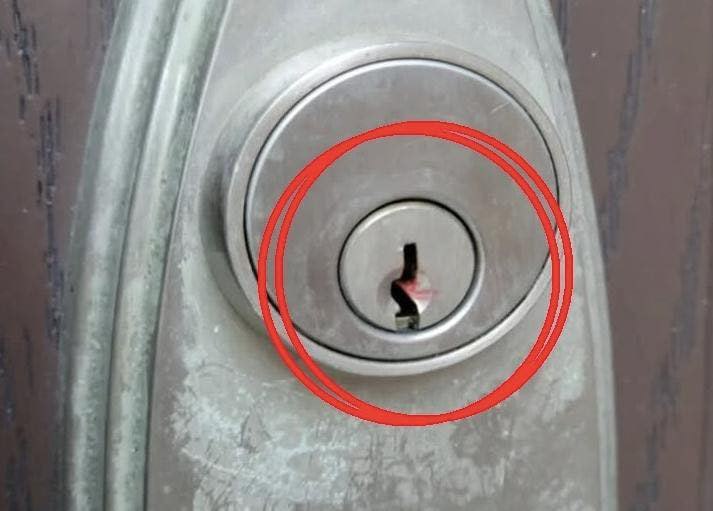Red Wax on Your Door Lock: A Silent Warning You Should Never Ignore
You pull into your driveway—maybe after a long day at work or a relaxing weekend away. As you walk toward your front door, something unusual catches your eye: a small dab of red wax on your door lock, nestled near the keyhole or smeared on the doorknob.
At first, it may seem harmless—maybe even a prank. But don’t brush it off. This small, strange mark could be a warning sign you should never ignore.
What Does Red Wax on a Door Lock Mean?
In recent years, homeowners across the globe have reported mysterious markings—red wax, chalk symbols, stickers, or string—appearing on or near their entryways. While not always malicious, these signs are increasingly linked to burglary scouting tactics or attempts to test home occupancy.
A Quiet Signal Between Criminals
Although it may sound like something from a crime novel, red wax has been documented in real-life cases as a covert marker used by burglars, squatters, or organized theft rings.
The wax is often:
- Placed in or near the door lock or keyhole
- Barely noticeable—often a small dot or smear
- Designed to break or smear when the door is used
Why Is It Used?
see continuation on next page
Why Is It Used?
The goal is simple: to test if a home is occupied.
If the wax stays undisturbed for several days, it may signal that:
- No one is home
- The property is vacant or unmonitored
- The house could be a target for break-ins
These techniques are often used alongside other suspicious behaviors, such as:
- Flyers or fake business cards placed on doors
- Knocking to “check for interest”
- Marking curbs, mailboxes, or light posts nearby
Other Strange Markings and What They May Mean
Aside from red wax, homeowners have reported other unexplained signs that could signal a potential security risk:
- Chalk or marker symbols on driveways or curbs
- Pebbles or sticks arranged near doors
- Thread or string tied to fences or door handles
- Dots, stickers, or small tags on windows or mailboxes
While some of these may seem random or innocent, they have been observed in neighborhoods before reported burglaries—especially in urban and suburban areas.
Are These Claims Backed by Police?
Some law enforcement agencies have acknowledged these signs as credible methods used by criminals. In both North America and Europe, police have issued public warnings after noticing patterns of symbols in areas with increased break-ins.
Authorities confirm that organized burglary groups may scout neighborhoods over time, using small, discreet markings to communicate which homes are most vulnerable.
What To Do If You Find Red Wax on Your Lock
1. Don’t Touch It Immediately
Take clear photos from different angles to document the wax’s position and appearance. This can help law enforcement investigate.
2. Report It to Local Authorities
Call your local non-emergency police number or reach out to a neighborhood watch group. Reporting suspicious activity helps authorities track potential threats.
3. Check Your Property Thoroughly
Inspect your home for other signs of surveillance or tampering:
- Displaced window screens
- Fresh chalk marks or stickers
- Objects left in front of the door to test for movement
- Unfamiliar flyers or cards that may be part of a tactic
4. Upgrade Your Home Security
Take steps to strengthen your home’s defenses:
- Install a smart lock or reinforced deadbolt
- Add a video doorbell or motion-activated lighting
- Use window locks or shatterproof film
- Consider a monitored security system, especially if you travel often
5. Talk to Your Neighbors
Ask around to see if others on your street have seen similar markings. Community awareness is a powerful crime deterrent.
Can It Be a False Alarm?
see continuation on next page
Can It Be a False Alarm?
Yes, sometimes there are innocent explanations:
- A child playing with a crayon or wax stick
- Wax from a delivery package or envelope
- A harmless prank or accidental mark
But when it comes to security, it’s always better to err on the side of caution. A quick response could prevent a potential break-in.
Final Thoughts: A Modern-Day Silent Alarm
The presence of red wax on your door lock might seem minor—but it can serve as a red flag for something more serious. Whether it’s part of a scouting tactic or simply a prank, your safest response is to treat it with suspicion, act promptly, and protect your home.
Burglars constantly evolve their methods—and so should your awareness.
If you spot red wax or similar markings, don’t ignore them. Stay alert, report it, and protect your peace of mind.












